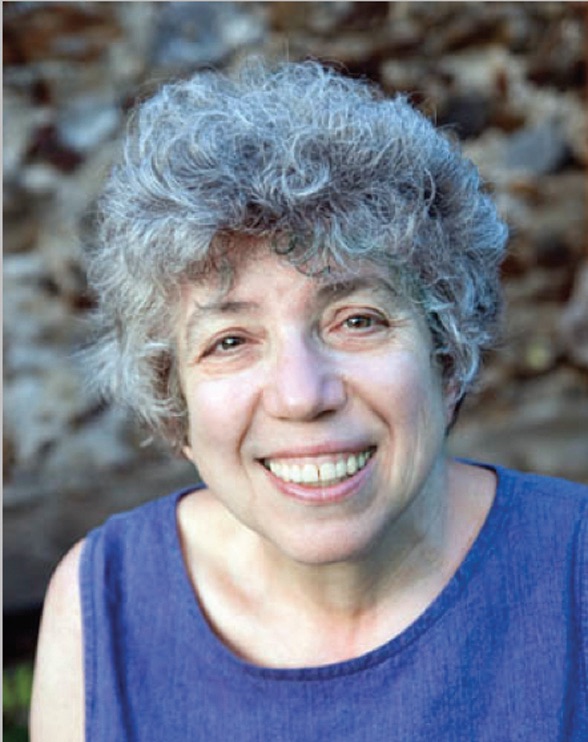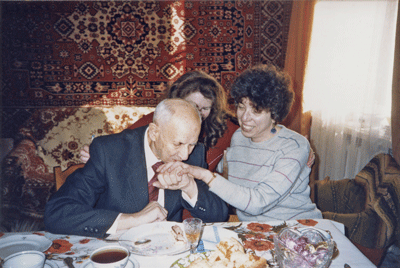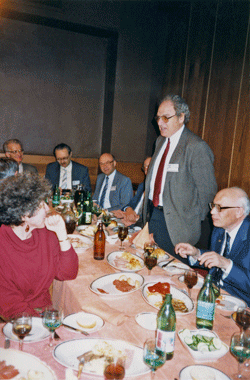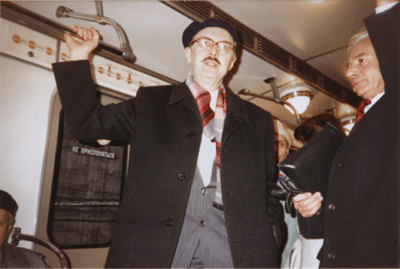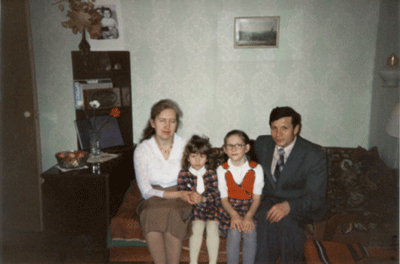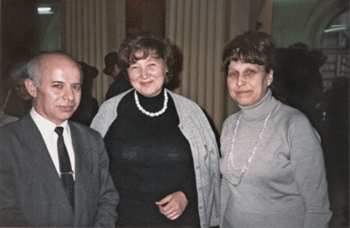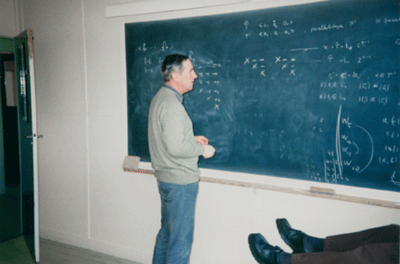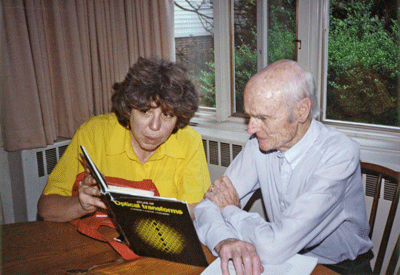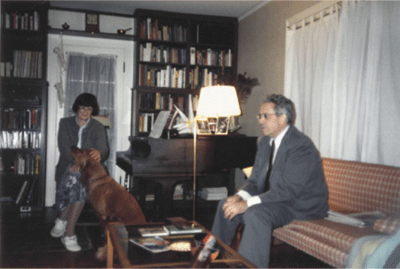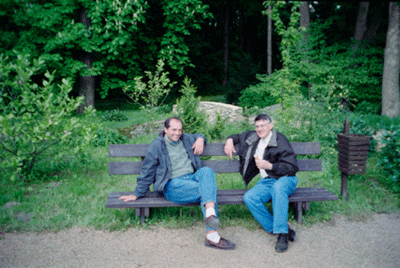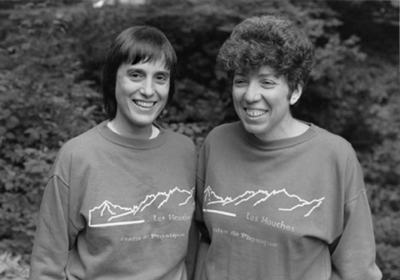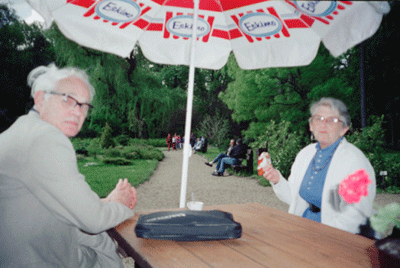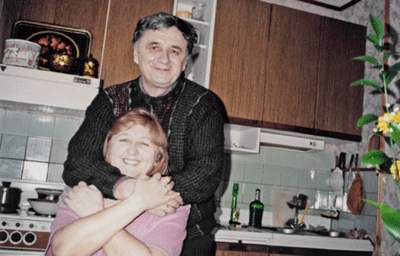Memoir - Marjorie SenechalMemoir | Publications | Curriculum Vitae | Videos | Slides | Articles | Obituary
Adventures of an Amateur CrystallographerMarjorie Senechal2013
I wish I could report that I collected crystals as a child, but I didn't collect anything. Collecting was pointless: my sisters and brother filched whatever I amassed. I did have an early interest in patterns, expressed by weaving unappreciated potholders from colored elastic loops stretched on a small square metal frame and pulled under-over with a hook. I was also fascinated by the Morse code. My parents gave me and my sister Norma a contraption for sending code by flashing lights, tapping keys, or short beeps. We rigged this up on our bunk beds and signaled through the night. Another pastime I see now as proto-mathematics (my family saw it as bizarre) was many happy hours spent organizing and reorganizing the buttons in the tin box by my mother's much-used Singer sewing machine. No one dared filch them, but we could play with them. There were dozens of buttons, of many kinds. Some were as large as a quarter, others smaller than a Dutch dubbeltje. Some were painted with flowers or faces. The materials differed too: wood, plastic, metal. I learned there are many ways to classify anything, and every organizing principle is quickly upended. Today I don't even try to organize my bookshelves. We lived on a farm, twelve hundred acres in the heart of the Kentucky bluegrass country. Meat was raised and butchered there, vegetables grown, cows milked, eggs laid, and bread baked. You are thinking: they must have had quite a staff. Yes we did; it numbered in the hundreds. What you need to know is: they all were federal prisoners, serving time for possession of drugs. The farm I grew up on was the famous Narcotic Farm, a U. S. government prison/hospital for heroin addicts. Farm work, and housework — we had "houseboys" too — was part of the cure. The farm was closed in the 1960s; now most of it is a public park. (Carol Brock rides her horse there.) But you can read about the old days in The Narcotic Farm. I'm not in the book but I'm a talking head, and cart-wheeling child, in the PBS film of that name, now on YouTube.[1] My father wasn't a farmer, he was a psychiatrist with the United States Public Health Service, then part of the United States Coast Guard. Instead of a lab coat, he wore a military uniform, complete with stripes on sleeves. The USPHS sent him to Narco (as the Narcotic Farm was called) in 1940, when I was one year old. Narco was a federal oasis in a semi-southern state. Kentucky was segregated; Narco was integrated. Other farms raised tobacco; Narco did not. When I was fifteen, my parents bought a house in Lexington, ten miles away. I had gone to school there all along, so the educational transition was smooth. But those fourteen formative years on the farm imprinted me forever. Unsupervised, I prowled where my curiosity led me. I climbed trees and rode horses. Maybe that's why I have never felt constrained by academic boundaries. I talked with whomever I chose: Kentucky drifters, Chicago jazz musicians, New York street criminals, Chinese laundrymen. Prisoners came and went and came back again; the relapse rate was 90%. And so I also learned that some problems, like drug addiction, are essentially intractable, and that any partial traction is achieved through the synthesis of multiple perspectives. I also learned that excellent work can be done in remote places for, in those years, Narco's Addiction Research Center (my father was associate director) was the world's leading center for addiction research. For several years I took piano lessons in Lexington from a brilliant young pianist and composer named Helen Lipscomb. Helen was a polio victim; she taught from her wheelchair. She lived with her mother; her father had died. Her brother Bill was a chemist at the University of Minnesota. Like all her students, I adored Helen. I didn't like much else in Lexington, and entered the University of Chicago without finishing high school. I had no clear idea of what I wanted to study in college. In those days no one expected girls to aim for careers, though in idle moments I saw my future self as an anthropologist in a remote Mexican village, or a reporter for the New York Times. Whatever: anything to escape the life my mother led, an infinite series of afternoon bridge games. My father did imagine a future for me, in medicine, though I had never shown any interest in it. I dutifully enrolled in a chemistry class at UC, but I was doomed from the start. Prof. Parsons, the teacher, assumed we'd passed high school chemistry, but I hadn't even taken it, I'd skipped it by leaving. I attended his lectures dutifully, but they were huge, and at 8 in the morning. The graduate students who ran the afternoon lab sessions harassed the few girls who showed up. Mathematics was a compromise, but not a grudging one: I enjoyed it. But I didn't know, or think to ask myself, what I enjoyed about it: which areas of math appealed to me and why; what stirred my imagination. Nor did I have any clear idea of a career. After UC, I churned on and earned an MS and PhD in mathematics at the Illinois Institute of Technology. Analytic number theory became my research topic because my advisor, an expert on summation formulas for divergent infinite series, had a grant from the ONR that included support for a graduate student. In graduate school I married a fellow mathematician. He completed his degree a few months before I did, and was hired by the University of Arizona. We moved to Tucson and I finished up in absentia. The department chair had promised me a job too, but once we were there he admitted that had just been a come-on. Indeed, he said, he could not hire me; the state had nepotism laws. We stayed two years, then taught six months in Fortaleza, Brazil (my husband had a Fulbright and I had a travel grant). Then we moved to Amherst, Massachusetts, where colleges, if not jobs, were plentiful. My first post-Ph. D. job was a one-year appointment (1966-67) in the mathematics department at Smith College, filling in for a woman who took the year off to have a baby. Though I had a two-year old daughter by then and was expecting another child in the spring, I persuaded the department chair to let me teach anyway. The baby would be born during spring vacation, I assured him. And indeed she was. My only problem, as the due date approached, was finding a gripping book to read in the hospital. Serendipity struck: in the science library I came across Crystals: their role in nature and science, by Charles Bunn. All I knew about crystals was that they were pretty. I checked it out and read it with increasing excitement in my few quiet moments the next week. I'd found the answer to my unasked questions. Crystals showed me what drew me to math: geometric forms, patterns, packings and tilings; and elegant puzzles like diffraction diagrams. The woman I'd replaced at Smith decided not to return. I was reappointed, this time for two years. And then three. And then permanently. Job security gave me respite to think. After Bunn, what? I was isolated; I had no one to ask. None of my colleagues in the Smith math department or at neighboring colleges (Amherst, Mount Holyoke, and the University of Massachusetts) were interested in crystallography or the math related to it. Smith's geology department was thriving, but even the mineralogists had little interest in the geometric side of their subject. I felt sure that math and crystallography could be combined in a way that pleased me, but I would have to find it myself. Just about that time I found an article by the polymathic Arthur Loeb, then a research scientist at the Kennecott Copper Company's laboratory in Lexington, Massachusetts, a two-hour drive from Northampton. I went to see him there and came home with a box of symmetry workbooks, wordless lessons with stick figure illustrations; I still have them somewhere. Arthur and Lotje Loeb soon became good friends of ours, with visits back and forth. In addition to the workbooks, Arthur gave me some of his "moduledra." These were tetrahedra, octahedra, and cuboctahedra made of Plexiglas. Some had jewel-like plastic spheres inside (representing atoms), others were empty. Arthur showed me the astonishing variety of simple crystal structures that can be modeled by fitting these occupied and unoccupied shapes together. Arthur also showed me Symmetry in Science and Art, a translation from the Russian of a book his friend V. A. Koptsik had written with the great Soviet crystallographer A. V. Shubnikov. This introduced me to color symmetry, which Shubnikov had pioneered; his 1951 Symmetry and Anti-symmetry of Finite Figures is a classic of the field. (Later, Shubnikov and his equally famous colleague N. V. Belov edited Color Symmetry. The Koptsik-Shubnikov book expanded these earlier ones.) Several western mathematicians had dabbled in color symmetry too. I found that color symmetry meant different things to different authors, and each had hatched his own notation. But on close examination all these different methods were exercises in group-subgroup relations. I wrote a short paper for Zeitschrift fur Kristallographie in which I pointed this out;[2] this put me in touch with a wide circle of mathematicians and crystallographers. Colored patterns became my new buttons. I spent hours in Smith's Art Library poring over a massive tome called The Grammar of Ornament, one hundred gilt-edged chromo-lithographed plates of ornamental patterns culled from cultures all over the world, and all times. Each plate showed dozens of intricate repeating patterns, a wealth of motifs: yet each pattern belonged to exactly one of seventeen symmetry types. Which? I studied The Grammar of Ornament to learn how to tell at a glance. One day a very senior professor of art noticed me browsing on his turf. He asked me (with curiosity, not hostility) what I, a mathematician, was doing there. I explained. "Do you know Dorothy Wrinch?" he asked me. I didn't. "You should," he said. "She is a crystallographer and she has a copy of that book. " I had no idea there was a crystallographer at Smith. Yet there was: though retired, Dorothy worked every day in her office in the physics department in Smith's new science center. I went to see her and explained my new-found interest in crystals. She was, she told me, writing a book on crystal geometry; I could help her by making models and illustrations. I saw this as an excellent way to fill in my very sketchy background. And so I became her informal, unpaid, post-doc. (We never finished the book.) Dorothy never told me she had been the epicenter of a controversy over the structures of proteins; she rarely talked about herself or her life. She taught me the basic notions of symmetry, not from a math text on group theory, but from F. M. Jaeger's Lectures on the Principle of Symmetry and its Applications in all Natural Sciences. I learned the importance of making models with my own hands, and studying them from every perspective. Dorothy stressed meaningful naming (hexahedra, not cubes!), exact diagrams, and succinct arguments. She was a demanding taskmaster; no vague or sloppy reasoning escaped her razor mind. More than any teacher I'd ever had (except my father) she held me to high standards. With two other colleagues I organized a Symmetry Festival in her honor, though she was by then too ill to attend. The proceedings were published as Patterns of Symmetry. I am grateful to have been introduced to crystallography by two such unusual individuals as Arthur and Dorothy. Both worked alone and were marginal in the profession. But they inhabited different regions of the margins. I admired Arthur for his intrepid versatility. Not only was he a crystallographer, he was a Renaissance dancer, and a designer, and pursued degrees in this and that with no plans to stop acquiring them. Dorothy was the better teacher, because she was genuinely interested my opinions and did me the honor of challenging them. Recently, interviewing people for her biography, I heard the same thing from her former students and from her younger relatives. At that time Dorothy was interested in twinned crystals. They became the driving force of my interest too, but not in the same direction. She was interested in twins because their macroscopic geometry held clues to their atomic structure: she hoped to infer protein structure from protein crystal shapes. But I had no interest in Friedel's laws relating twin symmetry to lattice coincidences, because they were hypothetical. And because they said nothing about how crystal twins grow. At that time, twins were still classified in the first instance as growth twins or mechanical twins, with each class divided into subclasses. Growth twins could be, it was thought, one of three types. Nucleation twins began in the nucleation stage. Contact twins formed later, when two crystallites bonded across a common facet or edge. Penetration twins appeared to grow right through each other. Nucleation and contact twins made sense to me intuitively, but penetration twins did not. It is a fundamental fact of physics that two objects cannot occupy the exact same space at the exact same time. Yet that is just what penetration twins — such as fluorite cubes — appear to do. On delving into the literature I saw that crystal symmetry and crystal growth are parallel worlds, and their dialogue a puzzle. 1974-75 was my first sabbatical year. I could go anywhere; Smith paid my full salary. The Loebs suggested spending it in Holland, their native country, because it is child-friendly. That was fine with me, because Holland was also home to Piet Hartmann and Wiepko Perdok, authors of the Periodic Bond Chain (PBC) theory of crystal growth, and they agreed to teach me. Perdok taught at the University of Groningen; we settled into nearby Paterswolde. The girls attended the local elementary school and soon spoke not only Dutch but also several dialects. The University of Groningen had been the home of the late Pieter Terpstra, author of 1001 Questions on Crystallographic Problems. Perdok put me through (some of) them, and taught me to use an optical goniometer. Both Terpstra and Perdok had been students of Jaeger, whose Lectures on the Principle of Symmetry Dorothy Wrinch had given me. I studied the Perdok-Hartman papers and worked with them on the structure of apatite crystals, enjoying new insights into human teeth.[3] I didn't see how to apply their PBC theory to twinning, but that didn't matter. For the first time, I was working in a real crystallography department, gaining a broader sense of the field and its denizens past and present. At Groningen I also met Aafe Vos, who kindly let me try x-ray diffraction. Once. It was immediately obvious that I was not an experimentalist. I am grateful to her too for another correction: she pointed out that my Dutch slang, while rich, was that of a seven year old. And indeed, I had picked it up from my children and their friends. When I returned to Massachusetts at the end of the year I learned that Dorothy Wrinch had had a stroke and was living year-round in her summer home in Woods Hole. In December her only child, Pamela, died in a fire; Dorothy died a few months later, in February, 1976. She had left her papers to the women's history archive at Smith College, the Sophia Smith Collection. Her son-in-law, Alfred Schenkman, asked me to read them and advise the archivist, lest the papers languish in boxes in a basement. Reading her letters, notebooks, and memos I glimpsed the outlines of her remarkable if contentious career. At Alfred's suggestion, I organized a symposium to honor her gift of her papers to the Sophia Smith Collection at Smith College. Arthur Loeb, who had been Pamela's neighbor in Cambridge and had met Dorothy a few times, spoke on his own work. The other speakers had been Dorothy's friends much longer: Caroline MacGillavry, Carolyn Cohen, David Harker, Ruth Hubbard, and George Wald. Alfred, the head of Schenkman Books in Cambridge (MA), published the transcripts of the lectures and some of the discussions in a volume I edited.[4]The Wrinch papers comprise some 30 boxes; she appeared to have saved every scrap, flattering and unflattering alike. "They'll never find stuff like that on me!" Martin Buerger exclaimed. But, writing her biography thirty-five years later, I found the real story in other archives. I met Carolyn Cohen and David Harker for the first time at the Wrinch papers symposium. Both became my good friends and encouraged me professionally. Through Harker, I attended meetings of the ACA; and he invited me to give a talk at the IUCr in Hamburg. My talk was historical, on "The Formation of the Lattice Hypothesis." I remember that Dorothy Hodgkin was in the audience, the one and only time I met her in person. She, and others, were relieved that I didn't talk about proteins. But I'm getting ahead of my story. While I was in Holland my enterprising student assistant at Smith had found, in Soviet Physics - Crystallography, an article by N. N. Sheftal' on tetrahedral penetration twins. She gave it to me on my return. It was just what I was looking for. The twins Sheftal' described had evidently begun as (111) contact twins, with the two crystallites rotated 60o with respect to one another. As they grew, he suggested, each crystal overgrew the edges of the other and proceeded to spread across the adjacent facet. When all was said and done, they looked like they'd grown through each other, but the reality was over-and-around. Brilliant! I thought. Could I apply this to cubes? No, evidently not. Cube facets are all (100) planes. But . . . these crystals might not have been cubes in their earliest stages, when twinning occurred! I wrote a paper on "The mechanism of certain growth twins of the penetration type" and sent it to Martin Buerger, editor of Neues Jarbuch für Mineralogie. This was before the Wrinch symposium; I had never met him. Buerger rejected it by return mail, mostly on the grounds that I hadn't quoted any of Buerger's many papers on twinning. And so I learned about turf wars in twin domains. In fact I hadn't read his papers but I quickly did. I added a reference to one of them, the paper was published, and we became friends.[5] After reading Professor Sheftal's paper I wrote to him in Moscow; a warm and encouraging correspondence ensued, and we wrote a paper together long distance.[6] Then I heard about the scientific exchanges between the Academies of Science of the USSR and USA. I applied to spend a year at the Shubnikov Institute for Crystallography, where Sheftal' worked. I would, I proposed, study crystal growth with him, and color symmetry with Koptsik. To my delight, I was accepted for an 11-month stay. Of course the children, now 11 and 14, would come too and attend Russian schools and learn Russian; they'd managed in Holland, hadn't they? Diana, my older daughter, was as delighted as I was. We had gone to Holland on a Russian boat, and she had fallen in love with the language. (Today she holds a Ph.D. in Slavic Languages and Literature from Yale.) Jenna was not delighted; she didn't want to miss a year of the television series "Little House on the Prairie." The children in her fifth grade class presented me with a petition. She shouldn't have to go to Russia, it said. But if she did have to go, she shouldn't have to go to school. But if she did have to go to school, she didn't have to learn anything. I turned them down, and we spent the academic year 1978-79 in Moscow. The girls braved the -45o cold — that merciless crossing point of the Fahrenheit and Centigrade scales — to trudge to their Russian schools. They learned Russian and enough other things to skip a year of school when they came home; and they made Russian friends. Moscow in those days was even more child-friendly than Holland. The streets and the subways were safe; they went to parties, concerts, and circuses on their own. Moscow was, however, less friendly to visiting adults. Social isolation, mainly, made it a divorce factory for American visitors; we divorced a few years after our return.
Senechal with N. N. Sheftal', Moscow, 1987.
The Director of the Shubnikov Institute at that time was the brilliant, charismatic Boris K. Vainshtein. I met him a few times that year, but mostly I was under his radar. Conversely, most of the Institute remained under mine. Now, reading the memorial to Vainshtein in Crystallography Reports, I see the range of things I might have learned: "growth, structure, and properties of bioorganic objects; new methods of studying the atomic and real structure of condensed matter; and new technologies for growing new crystals."[7] Nevertheless, the year at the Institute was invaluable. Not for crystal growth, not for color symmetry, but for an entirely new perspective on crystal geometry.
A crystallography banquet in Moscow in 1987: Senechal with, right to left,
Sheftal' had retired, but he had a desk in the lab of E. I. Givargizov, an expert on crystal whisker growth. So I was assigned to that lab too. It was a warm, informal, friendly place. One of the women working in it doubled as hairdresser (right there in the lab, during working hours). Language was a problem at first; my Russian was less than basic. Then I hit on the idea of exchanging lessons with my lab mates, who were eager to learn some English. Soon we were communicating, more or less, in both languages. Sheftal' told me he'd looked forward to my visit, hoping I'd be a vegetarian. Fortunately, he rebounded from that disappointment. (His wife, whom I never met, was upset that I was there; she was, he told me, afraid he'd be arrested for hosting an American. That was unlikely in the sleepy Brezhnev era; she had been scarred by the past.) Our discussions were interesting but we were too far apart in age, background, and experience to accomplish much. Color symmetry went nowhere because I saw Koptsik rarely. He taught at Moscow State University and stopped by from time to time to talk with me. There were high points too. One day the charming Belov invited me to his office for tea. At 85, he came to the Institute every day, always running up the five flights of stone stairs to his office, always in the same black leather jacket. At the end of a pleasant chat he said, "We consider Dorothy Wrinch the greatest American crystallographer. Not Martin Buerger." I didn't realize why until, years later, I studied vector maps.
Valentin I. Simonov (left) and Theo Hahn (right) on a Moscow subway, 1987.
Givargizov introduced me to a young crystallographer named Ravil Galiulin. Galiulin was also a mathematician, a student of B. N. Delone, of whom I had never heard. Galiulin plied me with papers on mathematical crystallography by Delone and his students, who, besides Galiulin, included N. V. Dolbilin and M. I. Shtogrin. In Delone I found my real teacher. I never met him (though I later learned that I could have). But on the basis of his papers and through my friendship with Galiulin, Dolbilin, and Shtogrin, I became and remain his disciple, trying always to emulate his clear and simple approach to crystallographic problems and his informal, lucid writing style. Delone's work has been the starting point for all of mine since then.
Ravil Galiulin with his wife and daughters, Moscow, 1987.
I would like to describe here, briefly, what Delone had done that captivated me so thoroughly. In 1934, together with the crystallographer N. V. Padurov and the mathematician A. D. Alexandrov, Delone published Mathematical Foundations of the Structural Analysis of Crystals (in Russian), in which they developed a new approach to crystal symmetry. Fedorov and other great mathematically-inclined crystallographers of the past had asked — and answered — such questions as: given a repeating pattern, what is its symmetry, or crystallographic, group? How many different crystallographic groups are there? Delone and his colleagues didn't take the pattern as given. They began with more general point sets, sets which could model the distribution of atoms in gases. These sets, which they called (r, R) systems (today they are called Delone sets), satisfy two axioms: first, no two points can be closer than the fixed distance r, and second, every sphere of radius R has at least one point of the set in or on it. From these simple hardcore and homogeneity axioms they drew a surprising amount of information about the geometry of the distribution of these points in space. Next, step-by-step, they constrained the way each point is surrounded by the others, until the point set became crystalline, or regular. Not only is this approach simple and elegant, it has turned out to be useful. Quasicrystals show us that sharp diffraction patterns are not the sole province of lattice structures. Evidently "order/disorder" is a spectrum, not a dichotomy. Delone sets are a tool for exploring that spectrum. Galiulin arranged for Patterns of Symmetry (the proceedings of my Symmetry Festival) to be translated into Russian, and we wrote an appendix updating it.[8] We also translated an important early work of Fedorov.[9] Galiulin also showed me a thought-provoking paper by Alan Mackay on generalized crystallography. The crystallographers there were familiar with his ideas, as Mackay had visited the Institute several times, but they were new to me. Galiulin talked about Fedorov, Wulff, Voronoi, Schoenflies, Sohncke, Niggli and other great crystallographers of the past as if they were alive and well and working down the hall. How was it possible that I had not read their foundational works? I was deeply embarrassed. Deus ex machina, soon after I returned to the United States Jose Lima de Faria invited me to write the chapter on the history of geometric crystallography for the Historical Atlas of Crystallography he was then preparing.[10] I snatched this chance to repair the gaps in my knowledge and threw myself into the history of science. Reading the original papers to prepare that chapter, I learned the wisdom of the adage "Read the masters!" Not only because secondary sources sometimes get things wrong, but because they are necessarily selective. The masters said more than their followers reported. The nuggets left behind were sometimes just the ones I needed. And so I became an amateur historian of science too.
E. I. Givargizov, Valentina Kirichenko, and an unidentified scientist, Moscow, 1979.
While still in Moscow, I was invited to a conference in Switzerland in August, 1979, in honor of Werner Nowacki's 70th birthday. The timing was right: I would leave Moscow in July. Fortunately, the invitation did not mention that to get to the conference venue you had to take a cable to the top of one sky-piercing peak, and then another across a terrifying chasm. But no cables snapped; all of us got there. Nowacki welcomed us; the Riederalp was his summer home. His student Peter Engel introduced himself; he had helped organize the conference. I met Alyosio Janner and Ed Ascher, who had re-derived the crystallographic groups in an elegant way, using a group theory tool called the Frobenius congruence; later I used it to derive the subgroups of space groups, needed for color symmetry theory.[11] Branko Grünbaum and Geoffrey Shepard talked about their effort to simplify and unify the vast international, multidisciplinary literature on tilings. Werner Fischer and Elke Koch talked about their work in mathematical crystallography. Alan Mackay was there too, urging crystallographers to expand their horizons. These scientists and others became the community in which I have worked.
Peter Engel at IHES, about 1985.
In 1981 I attended the IUCr meeting in Ottawa, my first. Two moments there were crucially important for me, though I didn't know that at the time. One was Alan Mackay's talk on the optical diffraction pattern produced by a Penrose tiling. Like the patterns in Harburn, Taylor, and Welberry's Atlas of Optical Transforms, he'd made a mask, a metal plate punched with tiny holes, and photographed the optical diffraction pattern it produced. But the holes were the vertices of Penrose tiles; the diffraction pattern should have been a blur. To the audience's astonishment, despite the apparent disorder of the mask, the diffraction pattern had ten-fold symmetry! Astonished, but oblivious to its importance. That would change a few years later. The other seminal moment was a brief meeting with a young metallurgist, Denis Gratias. I presented a poster on color symmetry; his poster was next to mine. At a moment when neither of us had visitors, we read each other's. Denis exclaimed, "Ah! You have to meet Louis Michel!" Louis Michel was an eminent French theoretical physicist at the Institut des Hautes Etudes Scientifiques in Bures-sur-Yvette, outside Paris. IHES, as the Institut is called, is modeled on the Institute for Advanced Study in Princeton. Like the IAS, IHES has a very small number of permanent faculty — Louis was one — who invite visitors to stay for a few days or months or years. Though best known for his research in particle physics, Louis had also written many papers on symmetry in physics. I had tried to read them, but he wrote in formal, abstract, take-no-prisoners mathematical language. I, a mathematician knowledgeable about symmetry, could not get through the first paragraphs. I told Denis I was afraid to meet Louis, and explained why. He laughed. "No, no, he is nothing like that in person!" Galiulin and other Russian colleagues came to the Ottawa meeting. They stayed together as a group. I was confused. Was I still more or less one of them, or was I now an outsider? Could I join them at breakfast? At lectures? At coffee breaks? But Galiulin was allowed to walk with me along the canal. He was writing a book; I proposed translating it into English. It would be a good idea, we agreed, if he could visit Northampton for a few months for that purpose. Eventually he did, but our translation project didn't pan out. After Ottawa, I had a professional-identity problem on my hands. What was my field? Mathematics? Crystallography? History of science? And who was I, a teacher in a liberal arts college or a member of the international research community? I decided not to choose, but to juggle instead. Smith College was an ideal setting for this juggling act. I could give courses on topics I wanted to learn, teaching myself along with bright students. There were no textbooks for these courses; I pulled the material together. Once I almost fell flat. I had announced a course on tilings and a respectable number of students had signed up. So the course was on, but the material wouldn't jell. Over the summer I discovered that the literature, such as it was, was too vast, too scattered, too full of holes, too contradictory, to synthesize for undergraduates. On the first day of class, I walked toward the classroom with dread, unsure how I would pull this off. On the way, I passed the mailroom. A package was waiting for me. I opened it and found a draft manuscript, "Tilings and Patterns," by Grünbaum and Shephard. They were developing their Riederalp lectures into a book. Would I be willing to read the draft and send them comments? I ran to the phone to ask for permission to copy it for my students; we would work through it together. The authors agreed, and the course was saved. So was I. Grünbaum and Shephard had read, understood, and synthesized the vast literature that defeated me, and they added much that was new, including the first coherent, detailed account of Penrose tilings and Ammann tilings. In classification, Shephard said, there are three things to consider: defining the objects to be classified, deciding on the classifications to be used, and enumeration. Alas, he said, very little work has been done on the first two, but the literature abounds with enumerations. He and Grünbaum wrote their book to set this right. They did not write it for crystallographers, but it is an important contribution to crystallography: careful definitions, a basic vocabulary, a clear distinction between what is and is not known. Tilings and Patterns is still the indispensable classic in the field. In those years, I organized and/or attended a great many conferences, large (ACA, IUCr) and small, in the U. S. and abroad, on mathematics and on crystallography. I will describe only the first one I organized. It took place two months after the Ottawa IUCr but had been arranged months earlier. This conference was a special session on "Discrete Geometry and its Applications" in a sectional meeting of the American Mathematical Society. By applications, I meant first and foremost crystallography, in the broadest sense. I had two motives: one, to get interesting people together; the other to show the AMS that mathematical crystallography was a lively field with challenging mathematical problems. Biology, molecular and macro, was represented by Don Caspar, who talked on "Symmetry and Asymmetry in Assemblies of Identical Protein Subunits," and by botanist Ralph Ericson on "Tubular Packings." The mathematician Hans Zassenhaus spoke "On the Sphere-Packing Problem" (Kepler's conjecture that the fcc lattice is the densest sphere packing in three dimensional space had not yet been solved). Doris Schattschneider spoke on "Tiling the Plane with Congruent Pentagons — the Non-Convex Case," H. S. M. Coxeter on "A Symmetrical Arrangement of Eleven Hemi-icosahedra," and Arthur Loeb on "Modularly simple complex structures: crystal systematics and kinship graphs." Crystal growth was modeled by Steven Willson in "Some Geometric Convergence Results for Certain Cellular Automata," and David Klarner in "Mathematical Crystal Growth." David Harker talked about on "The Confusing Nomenclature of Symmetry," and Richard Roth spoke on "On the Symmetric Colorings Associate with a Given Subgroup." Herbert Hauptman spoke on "The Phase Problem of X-ray Crystallography." I didn't know Herb when I invited him; David Harker had suggested him because, though Herb was a mathematician, he rarely had an opportunity to speak at mathematics meetings. (Of course, after he won the Nobel Prize in Chemistry, the American Mathematical Society saw fit to mention it in The Notices.) No one at that meeting mentioned Penrose tilings, or Alan Mackay's dramatic presentation in Ottawa.
Senechal with H. S. M. Coxeter, British-born Canadian geometer (~1985).
The Five College Committee on Applied Mathematics, to which I belonged, had funds for visiting lecturers. Remembering what Denis Gratias had told me in Ottawa, I suggested that we invite Louis Michel. Though no one else on the committee was interested in crystallography or symmetry, my suggestion was accepted immediately: Louis's broad interests, expertise and reputation were such that everyone had a stake in the visit. Denis Gratias was right: Louis the person was not the distant, austere, formal author of his papers. Louis the person was funny, lively, informal, and interested in everything. He also knew what he didn't know and was eager to learn from anyone who could teach him; I think that's why he took an interest in us. Much later, when I knew him well, I asked him why he wrote so formally. Why not write in a way people can understand? Louis, a devout Catholic, replied, "I don't write for people. I write for God." Louis accepted our invitation; this visit became the first of many and he invited our committee (one at a time) to IHES. Over the next few years I spent months there, working with him and other visitors on the applications of group theory to crystal lattices. We also studied Voronoi's posthumous Memoire. It was always a pleasure to visit IHES, and not only because of its stimulating scientific atmosphere and its location near Paris. Louis had worked with Niels Bohr in Copenhagen. He and his wife, Thérèse, were deeply impressed by the Bohrs' hospitality and the close relations among colleagues that they fostered and vowed to make their home in Bures a welcoming place. They succeeded. The scientists visiting Louis at any one time were always an eclectic bunch. At the Michels' dinner parties it was not unusual to speak one language with the person on your left, another with the person on your right, and a third with the person across the table. Thérèse, multilingual and ever-alert, rescued befuddled guests. Her sense of humor was as sharp as her husband's. At one dinner Louis held forth, at great length, on the intricate physics of the soufflé. Then Thérèse smiled sweetly and added, "But Louee has never been in zee kitchen."
Louis and Thérèse Michel in Northampton, MA, ~1990.
Louis and I and Peter Engel, another frequent visitor, were intrigued by a question Galiulin had asked me in Moscow concerning primitive unit cells. As every crystallographer knows, there are infinitely many ways to choose a unit cell for any lattice, but some are more convenient to work with than others. For example, the vectors a = (1,0) and b = (0,1) form the edges of a square, which is the obvious unit cell for the square lattice in the plane. The cell with edges a = (1, 2) and b = (-1, -1) is also a primitive cell for that lattice, but no one in their right mind would use it. Galiulin asked: is it always possible, in every dimension, to choose a cell defined by vectors all of whose coordinates are 0, 1 and -1? There were no important consequences either way, but we took this on and found that yes, there is such a cell for every lattice in 2, 3, . . . 7 dimensions. But we couldn't prove it for 8 dimensional lattices. The legendary genius John Conway was visiting IHES, so we asked him. "That's a nice bathtub problem," he said. The next morning he showed us a counterexample, an 8 dimensional lattice for which no such cell exists. Galiulin's conjecture failed, because Voronoi cells in 8 and higher dimensions have strange properties. I mention this because this isn't the only instance in which analogy fails in high dimensions; our intuition is unreliable there. With the advent of quasicrystals, high dimensional lattices and tilings have entered mathematical crystallography but this warning has not. Conway was at IHES to attend a month-long conference on mathematical crystallography in January, 1985. Louis and I had planned it for some time. I hadn't told Louis, but I was restless. Mathematical crystallography seemed to me, at that point, mainly classification and enumeration, normal science in the Kuhnian sense. Some of this was illuminating. It was at the Ottawa meeting, I think, that Galiulin and Hans Wondratschek from Karlsruhe came close to blows. The point of angry, red-faced contention was whether the number of crystal systems is six or seven. Both of these gentlemen could count to ten; the issue lay deeper, in their differing views of how crystal systems and crystal classes are defined. Louis Michel and Jan Mozyrzmas, a Polish physicist, carefully analyzed the various definitions and classifications and showed that, from the group theoretic point of view, the number of systems is unequivocally seven. But much — too much — mathematical crystallography involved classifying and enumerating special cases of special cases. It was, I thought, time to move on. Crystallography moved on instead. When I arrived in Paris for the conference, Louis shoved the latest issue of Physical Reviews Letters in my face. "Have you seen this?" he shouted. "Have you seen this?" The paper Louis showed me, "A metallic phase with long-range orientational order and with no translational symmetry," by Shechtman, Blech, Gratias, and Cahn, was astonishing. The diffraction patterns Alan Mackay had manufactured occurred in nature too! The lattice paradigm whose history I had spelled out at the Hamburg IUCr had been toppled. By the time the invited mathematicians, physicists, and crystallographers arrived in Bures for the conference, the program we had prepared so carefully was obsolete. By a wonderful coincidence, Shechtman, Gratias, and Cahn were in Paris just then. We invited them to join us. The invited lectures were given as planned, but the rest of the time we discussed Penrose tilings and diffraction. Penrose tilings are fascinating objects. They can be studied through several mathematical lenses. First, they are self-similar: they repeat on all scales. Second, they are modular: they can be built by juxtaposing two simple shapes by following prescribed matching rules (that look simple but aren't). And third, they can be obtained from an ordinary periodic cubic lattice by a technique called cut-and-project.[12] Briefly — and I grossly oversimplify here — one takes a high-dimensional lattice, slices it with a plane, and projects the lattice points lying near the plane onto it. If the plane itself contains no lattice points, or only one lattice point, then the projected pattern is nonperiodic. This projected pattern will always have sharp bright diffraction spots. For the Penrose tilings, the lattice in question is cubic and its dimension is five, and the cutting plane is orthogonal to the cube diagonal (1,1,1,1,1). This cutting plane can have exactly one lattice point in it (e.g., if it passes through (0,0,0,0,0) or none. It can't have more than one. The points of the five-dimensional lattice that are projected onto this plane don't form a lattice in that plane; they are a nonperiodic set. This point set diffracts as Mackay discovered. To get what Shechtman discovered, you do essentially the same thing, but instead the high dimensional lattice is six dimensional instead of five, and instead of cutting it with a plane you cut with a three-dimensional subspace. And then you project. This is harder to visualize but the idea is identical. Again, you are guaranteed a nonperiodic pattern whose diffraction pattern shows bright sharp spots. Soon crystallography hit the headlines. Are quasicrystals a new form of solid matter, or are they glasses, or crystal twins? If they're for real, what's quasi about them? What is a crystal? Mathematical crystallography wasn't normal any more. This was revolutionary science. I decided to stay. While crystallographers, chemists, physicists, and materials scientists debated those questions, we mathematicians were having a field day. We hoped, of course, that quasicrystals were real; but meanwhile we were writing a new chapter in The Grammar of Ornament. Aperiodic tilings and patterns leaped from board games to laboratories, and diffraction geometry shot to the top of our list of problems. Which point sets diffract? To answer that, the mathematical meaning of "diffract" had to be clarified. I'll skip over that and state the conclusion: a diffraction measure (and thus a diagram) is one of three types: 1) sharp spots, 2) sharp spots with a continuous (hazy) background, or 3) entirely continuous. "Which point sets diffract" means: what are the criteria that consign a point set to one or another of these three categories? For example, all lattices and regular systems of points are type 1; general (random) Delone sets are type 3. We knew, from Mackay's experiment, that Penrose tilings are type 1 too. The simplest mathematical proof of this makes use of the cut-and-project interpretation described above. That same interpretation gives us infinitely many different point sets of type 1 because the cut-and-project method can be used in infinitely many different way with any lattice in any dimension. By now it has been established that all points sets with type 1 diffraction patterns are essentially cut-and-project sets. But which point sets are type 2? Now, for the first time since my graduate student days, I thought about divergent series and summation formulas again.[13] I gave a lecture on Penrose tilings at the Perth IUCr meeting in 1987. This led to an invitation from Dan Shechtman to visit the Technion. Members of his own department, the materials science department, didn't understand what his discovery was all about. Would I give a lecture course on crystal symmetry, and teach his colleagues to read the International Tables? I was happy to accept: for years people had asked me to recommend a book on just those subjects and there was none. These lectures could become that book.[14] And, as an added bonus, I could visit my relatives in Haifa, Jerusalem, and Tel Aviv.
David and Deborah Harker at the Perth IUCr meeting (1987).
The IUCr created an Ad interim Commission on Modulated Structures, Polytypes, and Quasicrystals and appointed me to it; and later to its new ad-interim Commission on Aperiodic Crystals. The latter group was charged with, among other things, coming up with a new definition for "crystal." We debated long and hard. Some wanted to define a crystal to be either a periodic structure or one obtained by cut-and-project. (Not that the crystal actually came from higher dimensions, but it could be modeled by that construction.) The others — I belonged to this group — felt that might be too restrictive. We did not yet know which point sets are types 1, 2, or 3, we pointed out. In the end the Ad Interim Commission agreed on an ad interim definition: if it looks like a duck and quacks like a duck, it's a duck. "A crystal is any solid with an essentially discrete diffraction diagram," we said; if anyone asked, "essentially discrete" means types 1 and 2. This definition was contentious, as we expected. But it also posed a challenge: find geometric criteria for diffraction. The challenge has proved hard. A few years ago the Commission revisited the definition and decided not to change it — yet.
Dan Shechtman (right) and unidentified person, Budapest, ~1993. Now the field I had hoped to find when I knocked on Dorothy Wrinch's office door was burgeoning, with more conferences in more countries than anyone could possibly attend. I enjoyed my role as go-between, telling crystallographers about developments in mathematics and mathematicians about developments in crystallography. (See, for example, "Quasicrystals: the view from Les Houches," which Jean Taylor and I wrote at a quasicrystal conference.[15]) The United States was a glaring exception to this international flurry. The influential Linus Pauling's very public disparagement ("there are no quasicrystals, only quasiscientists") discouraged young researchers, and not only chemists. Several graduate students in physics told me their advisors had warned them to stay away from the subject because they would never find a job.
Jean Taylor (left) and Senechal, Les Houches, France, 1989.
For the first few years of the quasicrystal era, conferences were pan-disciplinary events. Theorists listened to experimentalists, and vice versa. We asked the same questions, and listened to each other. Where were the atoms? Which patterns diffract? Chemists, physicists, mathematicians, crystallographers, and metallurgists shared the same platforms and the same boxes of wine. We talked together, walked together and skied together. But the burgeoning interdisciplinary effort began pulling apart. Gradually, despite firm friendships and mutual respect, mathematicians began meeting with mathematicians, crystallographers with crystallographers, and so on. The main reason, I thought and think, was that each group began to see how difficult the scientific problems were and in response, honed its own tools to solve them. Before long these special tools were incomprehensible to anyone outside one's specialty.
Alan and Sheila Mackay in Budapest, ~1993.
I saw a need for a book on the basics of quasicrystal geometry, one that could supply a common background and vocabulary and introduce readers to Penrose tiles, diffraction geometry, the cut-and-project method, and more. Cambridge University Press invited me to write something; I took them up on it. In Quasicrystals and Geometry I explained, summarized and synthesized what seemed to me the most important questions that quasicrystals raised for mathematical crystallography and mathematics more generally.[16] (Quasicrystals are a gold mine for mathematicians, de Bruijn once said, and he was right.) My book is outdated now, but it's still a useful primer, and is even used as a textbook here and there.
Nikolai and Tanya Dolbilin, Moscow, 1998.
Throughout this time I was also working with Louis Michel and Peter Engel on a manuscript we called "Lattice Geometry." Louis was to present n-dimensional lattices from the group theory point of view (group action) and explain the connection between lattices and quadratic forms. I would discuss Delone sets and their Voronoi cells. Peter would describe the class of space-filling n-dimensional polyhedra called parallelotopes. It would be a text for crystallographers, physicists, and mathematicians, all together. Back and forth went the drafts, Louis writing for God, I trying to humanize it, and meanwhile Peter finding literally millions of parallelohedra in ever higher dimensions. We decided to perfect Lattice Geometrytogether in the fall of 2000. In the last days of 1999, a hurricane struck Bures, uprooting trees on the grounds of the Institute and also in the Michel's spacious yard. Louis spend the next day clearing debris; and that evening he had a stroke and died a few days later. (As I write this, in June 2013, Peter and I are still working on this book, now with another close colleague of Louis's, Boris Zhilinskii.) In October, 2011, when the Nobel Prize in Chemistry was announced, I felt like dancing in the street. The award to Shechtman — alone! — vindicated our hard work of a quarter century. "Quasicrystals have fundamentally changed the way chemists think about solid matter," the Nobel Committee said. As Danny generously told Israeli television that day, we all had earned it. At least, we felt we had. Pat Thiel invited me to contribute to a special issue of the Israel Journal of Chemistry in Danny's honor, on very short deadline. I decided to return to my crystallographic roots. My early ideas on twinning were still on the table: "For this interesting theoretical model no experimental proof is yet available, but it appears rather reasonable," Hahn and Klapper wrote in 2003.[17] I used this opportunity to call for a complete rethinking of crystal twins. The distinction between contact and penetration twins had been abandoned by then, and nanotechnology and modern imaging let us watch crystals' early growth stages. Computer models of those early stages suggest surprising, and surprisingly similar, geometries for all states of condensed matters.[18] I wish I were starting all over again. I will conclude with brief remarks about the other balls, besides crystallography and mathematics, that I've juggled over the years. History of science and technology is one of them. For years, off and on, I directed the history of science program at Smith. Eventually I managed to get my appointment changed to half time in that program, half in mathematics; this enabled me to teach history of science regularly, instead of as "released time." Also at Smith I founded a liberal arts institute to promote cross-disciplinary research among the faculty.[19] (Thanks to a generous bequest to the College from alumna Louise Wolff Kahn, the institute is called the Kahn Institute.) Each year a committee selects topics of broad interest from those submitted by the faculty, and invites applications for year-long research seminars. Ten faculty are selected for each seminar by the committee, and the faculty selects ten students. I directed the institute for its first eight years, and then handed it over to an excellent and able successor. In the 1980s, in our local bookstore, I came across Chronicle in Stone on the remainder table. The author was an Albanian writer I'd never heard of, Ismail Kadare. I was taken by the book, as was my new husband, Stan Sherer, a photographer; we decided to go to Albania and see for ourselves. The country was closed then, but travel became possible in the 1990s and so we went, ten times so far. Our book, Long Life to Your Children!, is our testament to the remarkable people we met there.[20] In a second-hand shop in Albania I noticed old shawls that shone like silk but were coarse and poorly woven. Might this silk have been raised and woven at home? Yes it was, the shopkeeper told me; everyone raised silkworms in Albania until recently. A long tradition of sericulture in the Balkans, I learned, had been mostly abandoned by the 20th century. But in the communist era Albania was allied with China, not Russia; and sericulture was restarted in Albania with Chinese help. I was fascinated and wanted to learn more, but I knew nothing about sericulture. Then I remembered that Northampton, Massachusetts had been the home of the Corticelli Company, which made silk thread. Surely I could find information in our local library. But no: all I found were some 1830s sericulture manuals. With a Smith colleague, I launched a town-gown history recovery project. For the next ten years, we and our students pored over local archives, reconstructed 1830s silk-winding equipment, mounted exhibits, hosted expert visitors, and even raised silkworms. The Northampton Silk Project website is still on line.[21] After 42 years at Smith, I retired from teaching in July, 2007 to make time for two big projects. One was to edit The Mathematical Intelligencer, an international quarterly then in its 30th year. The Intelligencer publishes expository articles on all kinds of mathematics, pure and applied. It's a journal of mathematical culture too, with articles on the history and philosophy of mathematics, and on the diversity of mathematical communities and mathematical thought. We have a humor column, and occasional puzzles, poetry, fiction, and art. My other big project was a biography of Dorothy Wrinch. I had given a lecture on her papers soon after her death, and thought I had said all I had to say. But that lecture, though published, was not widely circulated;[22] and it was based on her papers alone. Later quite a bit was written about Dorothy, some fiercely pro and more fiercely con, and most of it wrong. Wrong facts, wrong interpretation, and more than a few fictions. The errors propagated: writers who never knew her uncritically adopted the attitudes of people who had and added to the misinformation. Moreover, these writers saw her through the lens of chemistry. But Dorothy had been a trained as a mathematician, had studied logic with Bertrand Russell, and was a disciple of D'Arcy Thompson; Growth and Form was her bible. There was more to her story and I set out to find it. Finding it was an education in hidden history. Alan Mackay, Andrew Donald Booth, Kathleen Britten Booth, Carolyn Cohen, and Bill Lipscomb made helpful suggestions. In archives in England, Canada, and the United States, I read letters to and from Bertrand Russell, D'Arcy Thompson, J. D. Bernal, Joseph Needham, Dorothy Hodgkin, Irving Langmuir, Isidor Fankuchen, both Braggs, and many more. By the time I finished, I felt as if I'd known all of them personally. And then there are the archives of the Rockefeller Foundation and Warren Weaver's oral history. In the 1930s, as Weaver tried to jump-start molecular biology and encouraged mathematicians and physicists to go into that field, the Foundation sent its officers to labs around the world, not only to see what was going on but to find out what people thought about each other. At night, they recorded the candid comments in their private eyes-only diaries. These are open to scholars now. Personalities and ambitions and who's right, who's wrong aside, I came to see Dorothy Wrinch's protein model as a lightning rod for a clash of scientific cultures. The clash is the eternal dialogue between truth and beauty, between complexity and simplicity, a dialogue both profound and productive. Indeed, it is an engine of science. And so I called my book I Died for Beauty: Dorothy Wrinch and the Cultures of Science.[23] I have returned to Russia almost annually, sometimes for scientific conferences, but also in connection with a joint US- Russian program for science education called Basic Research and Higher Education. When the Soviet Union fell, science budgets fell with it. George Soros started an International Science Foundation to help keep science in Russia and the former states of the Soviet Union alive; a few years later he closed it and donated five million dollars toward a new one, and the funding was matched by the United States congress. Since my year in Moscow, I had served on various scientific exchange committees in Washington; now I was appointed to the board of directors of the new foundation, the Civilian Research and Development Foundation (CRDF for short; now CRDF Global, as it has expanded world-wide). With equal funding from the MacArthur Foundation and the Russian Ministry of Science and Education, CRDF established science-and-education centers in twenty Russian universities. The program was overseen by a hands-on bi-national governing council; I was the American co-chair. Each year we held a meeting of representatives from all the centers, the venue rotating among them. The year 2008 was the University of Nizhny Novgorod's turn. The University has a small museum honoring Belov, who had spent many years there. One display included his hand-made Beever-Lipson strips. And the center's director turned out to be a crystallographer, Evgeny Chuprunov, a friend from my Shubnikov Institute days. (Today he is the university's Rector.) Incredibly — how could thirty years pass so quickly? — we were the senior people at the gathering and had to give the first toasts. I lifted a glass to scientific exchange and cooperation.
References [1] See also my mini-memoir "Narco Brat," in Of Human Bondage: historical perspectives on addiction, D. Patey, ed., Smith College Studies in History, 2003: 173 - 200. A pdf is available at http://www. marjoriesenechal. com [2] "Point groups and color symmetry", Zeitschrift fur Kristallographie, 142, 1975, 1-23. [3] "F faces of apatite and its morphology: theory and observation", Journal of Crystal Growth 78 (1986), 468-478. (with R. A. Terpstra, P. Bennema, P. Hartman, C. F. Woensdreght and W. G. Perdok) [4] M. Senechal, editor. Structure of Matter and Patterns in Science. Proceedings of a symposium inspired by the work and life of Dorothy Wrinch, September 1977. Schenkman Publishing Co., Cambridge 1980, 210 pp. [5] "The mechanism of formation of certain growth twins of the penetration type", Neues Jarbuch fur Mineralogie, 11, 1976, 518-524. [6] "The formation of penetration twins", in Processes of Real Crystal Formation, edited by N. V. Belov, Nauka, Moscow, 1977, 61-64, in Russian. (with N. N. Sheftal) [7] (Crystallography Reports, Vol. 46, No. 4, 2001, p. 523. Translated from Kristallografiya, Vol. 46, No. 4, 2001, pp. 585-586. Original Russian Text Copyright © 2001 by Kovalchuk. ) [8] "Recent advances and unsolved problems in symmetry theory", in Uzori Symmetrii. In Russian. (with R. V. Galiulin) [9] "An introduction to the theory of figures: the geometry of E. S. Fedorov", Structural Topology, 10, 1984, 5-22. (with R. V. Galiulin) [10] "A brief history of geometrical crystallography", in An Historical Atlas of Crystallography, edited by J. Lima de Faria, Kluwer Academic Publishers, 1990, 43-59. [11] "A simple characterization of the subgroups of space groups", Acta Crystallographica, A36, 1980, 845-850. [12] See Quasicrystals and Geometry, chapter 6. Full citation below. [13] "From summation formulae to lattices and back again", in Voronoi's Impact on Modern Science, Halyna Syta, ed. , Institute of Mathematics, Kyiv, 1998, pp. 60-70. [14] M. Senechal, Crystalline Symmetries: An informal mathematical introduction. Institute of Physics, Alan Hilger, Ltd. , 1990. [15] "Quasicrystals: the view from Les Houches", with Jean Taylor. The Mathematical Intelligencer, Vol. 12, No. 2, 1990, 54-64. [16] M. Senechal, Quasicrystals and Geometry, Cambridge University Press, 1995; corrected paperback edition 1996. [17] Th. Hahn and H. Klapper, "The Twinning of Crystals," International Tables for Crystallography, Vol. D, 2003 [18] See M. Senechal and J. E. Taylor, "Quasicrystals: the view from Stocholm," to appear in The Mathematical Intelligencer. [19] http://www. smith. edu/kahninstitute/ [20] S. Sherer and M. Senechal, Long Life to Your Children! A portrait of High Albania, University of Massachusetts Press, Amherst, 1997, 240 pp. [21] http://www. smith. edu/hsc/silk/. See also M. Senechal, Northampton's Century of Silk, City of Northampton's 350th anniversary chapbook series, 2004, 90 pp.; M. Senechal, editor (and contributor), Silk Unraveled!, Smith College Studies in History, Vol. LIII, 2005, 274 pp.; and J. Field, M. Senechal, and M. Shaw, American Silk: 1832 - 1932, Texas Tech University Press, 2007, 326 pp. Winner of the American Costume Society's Millia Davenport Publication Award, 2008 [22] "A prophet without honor, Dorothy Wrinch 1894-1976", Smith Alumnae Quarterly, April 1977, 18-23. [23] M. Senechal, I Died for Beauty: Dorothy Wrinch and the Cultures of Science, Oxford University Press, 2013. |

